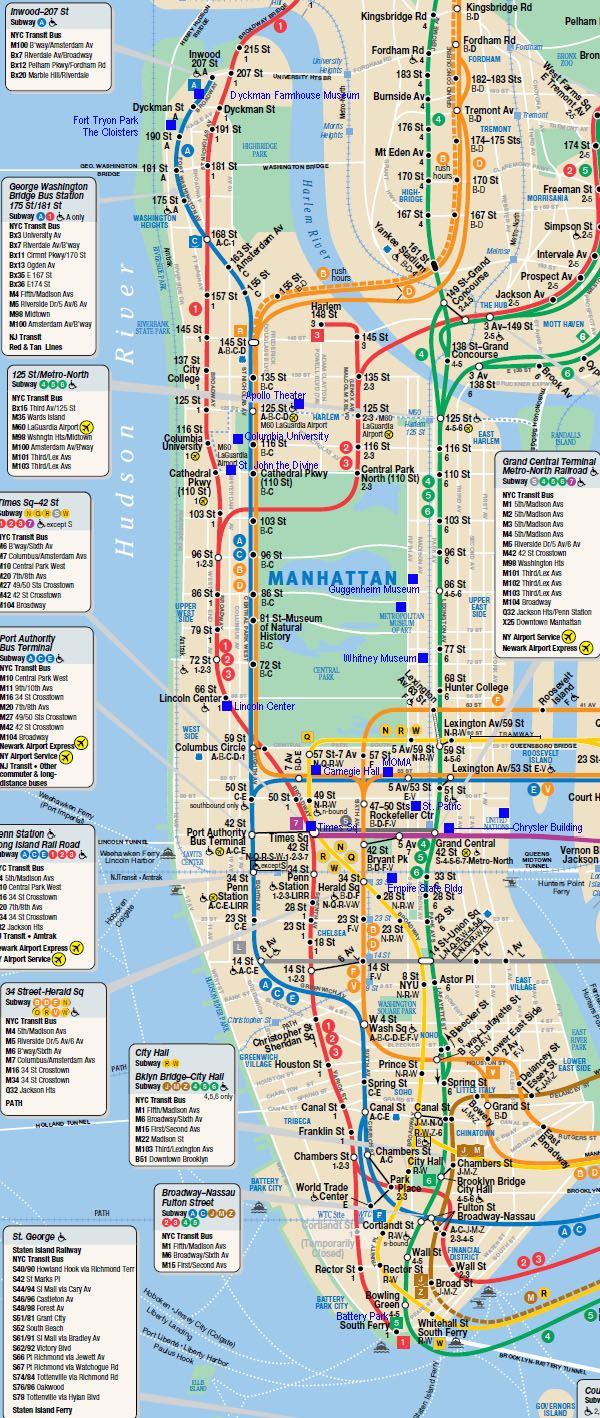
The Subway has signs that hang from the stations' ceilings to show the routes and where they go. Many people who have never ridden on the Subway get confused because there are so many routes going to so many different places. The transit authority shows planned service changes on its website, on station walls, inside subway cars, and through its Twitter page.
#Manhattan subway map j line free
When a line is closed, the transit authority uses free shuttle buses.

The subway system runs 24 hours a day and 7 days a week, but some routes do not run when not many people ride the subway. There is one "skip-stop" service, the J/Z, where two train routes run on the same line each route only stops at every other station along the line. "Express" trains skip some stations, but stop at "express" stations. "Local" trains make all stops at "local" stations as well as at "express" stations. There are three different types of subway services. However, tourists often use colors to tell between routes. People who live in New York City do not call lines and services by color (such as, Blue Line or Green Line). Before, subway maps used different colors for every route. Raleigh D'Adamo, a lawyer who entered a contest in 1964, planned the colors that are used on subway maps now. "Lines" have names, like "Broadway Line". "Routes", also called "services", have a letter or a number, such as "1" or "A". In New York City's subway system, however, the "line" is the actual tracks, which a train "route" uses. In other cities' subway systems, a train "line" is the same as a train "route". The 125th Street station on the IRT 7th Avenue Line People wait for trains on these platforms.Īll new stations have platforms with air conditioning. Most subway stations have waiting platforms that are from 480 to 600 feet (150 to 180 m) long. Some of the balls do not show the right information about an entrance or exit. There are also red exit lamp posts, which show that you can only exit the station. An entrance lamp post with a red ball can show that you can only enter during the daytime. Green balls usually show the station is open all day. At the top of the lamp posts are colored balls. Many station entrances and exits have lamp posts. They are usually between street level and platform level. Everyone must pay a fare to enter the subway system. These are the levels of the station where you pay a fare before entering the subway platforms. 463 out of the system's 472 stations are always open. Every day about 5,076,000 people take rides on the subway. About 40% of the tracks are above ground and the other 60% are below ground.

There are subway stations in Manhattan, Brooklyn, Queens, and the Bronx. In 2012, Hurricane Sandy flooded the subway system. Īfter the September 11 attacks, there were train disruptions on lines running through Lower Manhattan.

There was a lot of graffiti and crime on the subway. There were very few people riding the subway. It was made part of Metropolitan Transportation Authority in 1968.īy the 1970s and 1980s, the New York City Subway was really bad to ride. The New York City Transit Authority (NYCTA) was made in 1953 to run subway, bus, and streetcar operations. Some elevated train lines closed and were destroyed. In 1940, the two private systems were bought by the city. The first line of the city-owned and city-run Independent Subway System (IND) opened in 1932. These tracks were leased to the companies. Most subway lines built after 1913 were built by the New York City government.

They were the Brooklyn Rapid Transit Corporation (BRT) and the Interborough Rapid Transit Company (IRT). That railroad opened in 1863.īy the time the first subway opened, there were two private subway companies. The oldest right-of-way was a steam railroad called the Brooklyn, Bath and Coney Island Rail Road. The oldest elevated train line in the subway system opened in 1885. The first underground subway line opened on October 27, 1904. It could have gone to Battery Park to the south and the Harlem River to the north. The subway car in the tunnel was pneumatic, or pushed by air. His Beach Pneumatic Transit only extended 312 feet (95 m) under Broadway in Lower Manhattan. Alfred Ely Beach built an underground subway tunnel to test in 1869.


 0 kommentar(er)
0 kommentar(er)
